Microstructures and Mechanical Properties of 7Mn Steel Manufactured by Different Rolling Processes
Abstract
:1. Introduction
2. Materials and Experimental Methods
3. Results
3.1. Microstructural Examination
3.2. Mechanical Properties
4. Discussion
5. Conclusions
- The hot-rolled and annealed microstructures are mostly composed of lamellar austenite and ferrite grains; whilst the cold-rolled ones composed of equiaxed austenite and ferrite grains. In contrast, the warm-rolled and annealed microstructures are the mixture of hot-rolled and cold-rolled ones because the warm rolling produces both martensite and some equiaxed ferrite grains, which then transform to lamellar and equiaxed austenite grains during the IA, respectively. As a result, the warm rolling and IA process leads to γ/α grains having both lamellar and equiaxed morphologies.
- Among the three studied steels, the largest fraction of RA grains transformed to martensite during the deformation of warm-rolled and annealed steel, leading to the best combination of UTS and TE. This is due to the RA grains in the warm-rolled and annealed steel having two different morphologies and a wide size distribution, which may result in a more sustainable transformation during deformation than that in hot-rolled and cold-rolled ones.
- The warm rolling process also leads to the extensive precipitation of cementite, which could not dissolve completely during the subsequent IA at 700 °C for 5 h. The remaining cementite particles may strengthen the coarse ferrite grains, resulting in the highest YS observed in the warm-rolled and annealed steel.
- The hot-rolled and annealed steel exhibits continuous yielding during the tensile deformation; in contrast, the cold-rolled and warm-rolled ones both exhibit discontinuous yielding. The yield point elongation of warm-rolled and annealed steel is smaller because the fraction of relatively coarse and equiaxed ferrite grains is smaller and strengthened by the un-dissolved carbide particles with fine size.
Acknowledgments
Author Contributions
Conflicts of Interest
References
- Lee, Y.K.; Han, J. Current opinion in medium manganese steel. Mater. Sci. Technol. 2015, 31, 843–856. [Google Scholar] [CrossRef]
- Suh, D.W.; Kim, S.J. Medium Mn transformation-induced plasticity steels: Recent progress and challenges. Scr. Mater. 2017, 126, 63–67. [Google Scholar] [CrossRef]
- Cao, W.Q.; Wang, C.; Shi, J.; Wang, M.Q.; Hui, W.J.; Dong, H. Microstructure and mechanical properties of Fe–0.2C–5Mn steel processed by ART-annealing. Mater. Sci. Eng. A 2011, 528, 6661–6666. [Google Scholar] [CrossRef]
- Shi, J.; Sun, X.J.; Wang, M.Q.; Hui, W.J.; Dong, H.; Cao, W.Q. Microstructure and mechanical properties of Fe–0.2C–5Mn steel processed by ART-annealing. Scr. Mater. 2010, 63, 815–818. [Google Scholar] [CrossRef]
- Xu, H.F.; Zhao, J.; Cao, W.Q.; Shi, J.; Wang, C.Y.; Wang, C.; Li, J.; Dong, H. Heat treatment effects on the microstructure and mechanical properties of a medium manganese steel (0.2C–5Mn). Mater. Sci. Eng. A 2012, 532, 435–442. [Google Scholar] [CrossRef]
- Wang, C.; Shi, J.; Wang, C.Y.; Wang, M.Q.; Dong, H.; Cao, W.Q. Development of ultrafine lamellar ferrite and austenite duplex structure in 0.2C5Mn steel during ART-annealing. ISIJ Int. 2011, 51, 651–656. [Google Scholar] [CrossRef]
- Zhao, C.; Cao, W.Q.; Zhang, C.; Yang, Z.G.; Dong, H.; Weng, Y.Q. Effect of annealing temperature and time on microstructure evolution of 0·2C–5Mn steel during intercritical annealing process. Mater. Sci. Technol. 2014, 30, 791–799. [Google Scholar] [CrossRef]
- Gibbs, P.J.; Moor, E.D.; Merwin, M.J.; Clausen, B.; Speer, J.G.; Matlock, D.K. Austenite stability effects on tensile behavior of manganese-enriched-austenite transformation-induced plasticity steel. Metall. Mater. Trans. A 2011, 42, 3691–3702. [Google Scholar] [CrossRef]
- Aydin, H.; Jung, I.-H.; Essadiqi, E.; Yue, S. Twinning and Tripping in 10% Mn steels. Mater. Sci. Eng. A 2014, 591, 90–96. [Google Scholar] [CrossRef]
- Suh, D.W.; Park, S.J.; Lee, T.H.; Oh, C.S.; Kim, S.J. Influence of al on microstructure and mechanical behavior of cr-containing transformation-induced plasticity steel. Metall. Mater. Trans. A 2010, 41, 397–408. [Google Scholar] [CrossRef]
- Han, J.; Lee, S.J.; Jung, J.G.; Lee, Y.K. The effects of the initial martensite microstructure on the microstructure and tensile properties of intercritically annealed Fe–9Mn–0.05 C steel. Acta Mater. 2014, 78, 369–377. [Google Scholar] [CrossRef]
- Luo, H.W.; Qiu, C.H.; Dong, H.; Shi, J. Experimental and numerical analysis of influence of carbide on austenitisation kinetics in 5Mn TRIP steel. Mater. Sci. Technol. 2014, 30, 1367–1377. [Google Scholar] [CrossRef]
- Hu, B.; Luo, H.W. A strong and ductile 7Mn steel manufactured by warm rolling and exhibiting both transformation and twinning induced plasticity. J. Alloys Compd. 2017, 725, 684–693. [Google Scholar] [CrossRef]
- Hu, B.; Luo, H.W.; Yang, F.; Dong, H. Recent progress in medium-Mn steels made with new designing strategies, a review. Mater. Sci. Technol. 2017. [Google Scholar] [CrossRef]
- Saleh, M.H.; Priestner, R. Retained austenite in dual-phase silicon steels and its effect on mechanical properties. J. Mater. Process. Technol. 2001, 113, 587–593. [Google Scholar] [CrossRef]
- BabU, S.S.; Specht, E.D.; David, S.A.; Karapetrova, E.; Zschack, P.; Peet, M.; Bhadeshia, H.K.D.H. In-situ observations of lattice parameter fluctuations in austenite and transformation to bainite. Metall. Mater. Trans. A 2005, 36, 3281–3289. [Google Scholar] [CrossRef]
- Sohn, S.S.; Song, H.; Suh, B.C.; Kwak, J.H.; Lee, B.J.; Kim, N.J.; Lee, S. Novel ultra-high-strength (ferrite + austenite) duplex lightweight steels achieved by fine dislocation substructures (Taylor lattices), grain refinement, and partial recrystallization. Acta Mater. 2015, 96, 301–310. [Google Scholar] [CrossRef]
- Cai, Z.H.; Ding, H.; Misra, R.D.K.; Ying, Z.Y. Austenite stability and deformation behavior in a cold-rolled transformation-induced plasticity steel with medium manganese content. Acta Mater. 2015, 84, 229–236. [Google Scholar] [CrossRef]
- Bouaziz, O.; Allain, S.; Scott, C.P.; Cugy, P.; Barbier, D. High manganese austenitic twinning induced plasticity steels: A review of the microstructure properties relationships. Curr. Opin. Solid State Mater. Sci. 2011, 15, 141–168. [Google Scholar] [CrossRef]
- Wang, X.G.; Wang, L.; Huang, M.X. Kinematic and thermal characteristics of Lüders and Portevin-Le Châtelier bands in a medium Mn transformation-induced plasticity steel. Acta Mater. 2017, 124, 17–29. [Google Scholar] [CrossRef]
- Lee, S.; Kim, J.; Lee, S.J.; de Cooman, B.C. Effect of nitrogen on the critical strain for dynamic strain aging in high-manganese twinning-induced plasticity steel. Scr. Mater. 2011, 65, 528–531. [Google Scholar] [CrossRef]
- Hall, E.O. The deformation and ageing of mild steel: III discussion of results. Proc. Phys. Soc. Sect. B 1951, 64, 742–747. [Google Scholar] [CrossRef]
- Luo, H.; Dong, H.; Huang, M.X. Effect of intercritical annealing on the Lüders strains of medium Mn transformation-induced plasticity steels. Mater. Des. 2015, 83, 42–48. [Google Scholar] [CrossRef]
- Emadoddin, E.; Akbarzadeh, A.; Daneshi, G.H. Correlation between Luder strain and retained austenite in TRIP-assisted cold rolled steel sheets. Mater. Sci. Eng. A 2007, 447, 174–179. [Google Scholar] [CrossRef]
- Lloyd, D.J.; Morris, L.R. Luders band deformation in a fine grained aluminium alloy. Acta Metall. 1977, 25, 857–861. [Google Scholar] [CrossRef]
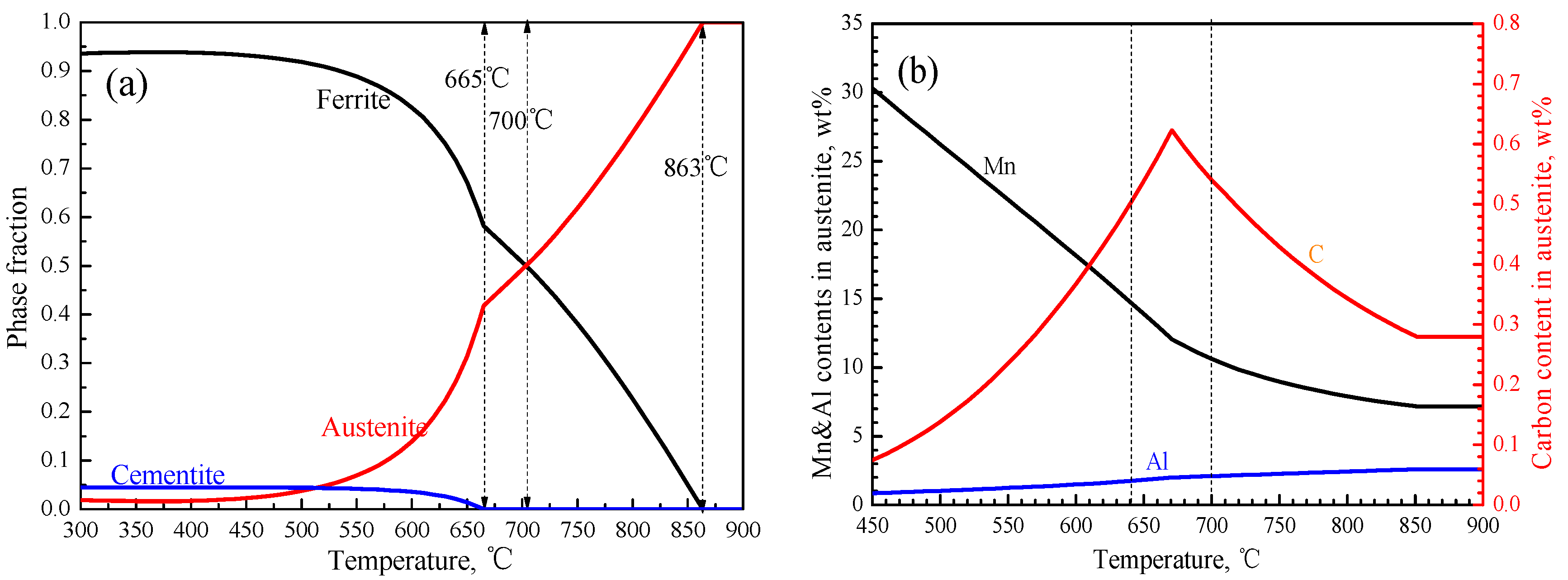
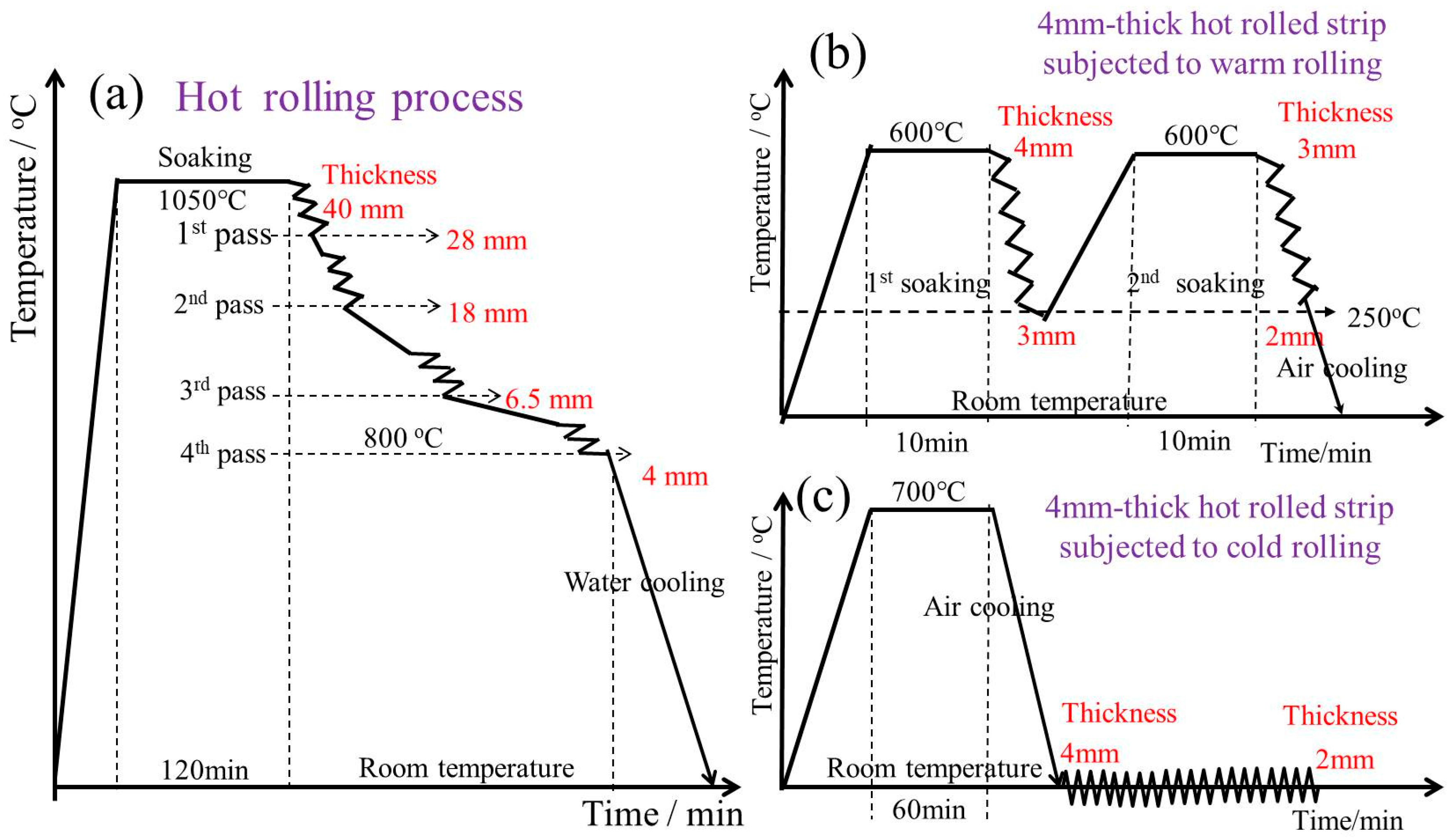

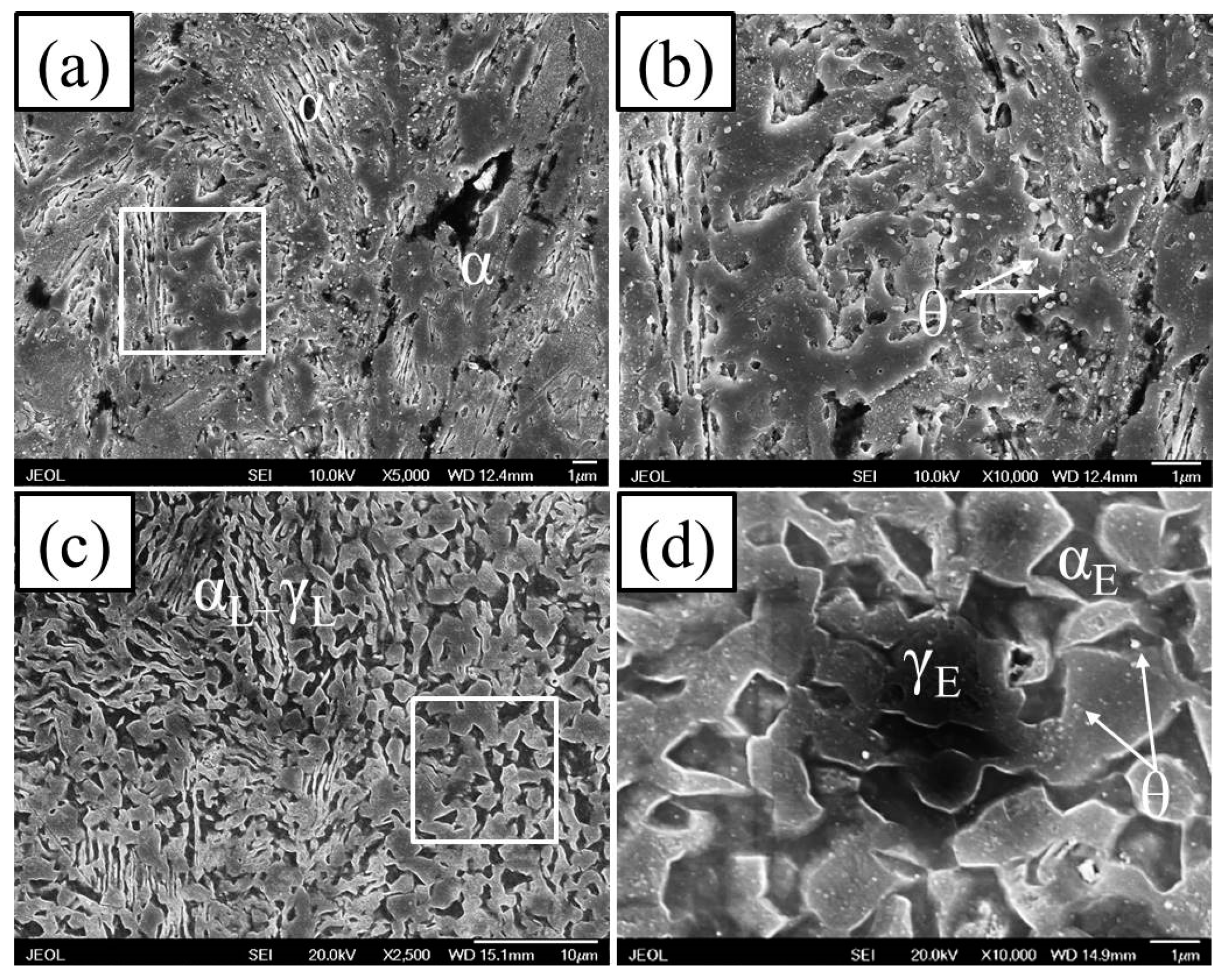
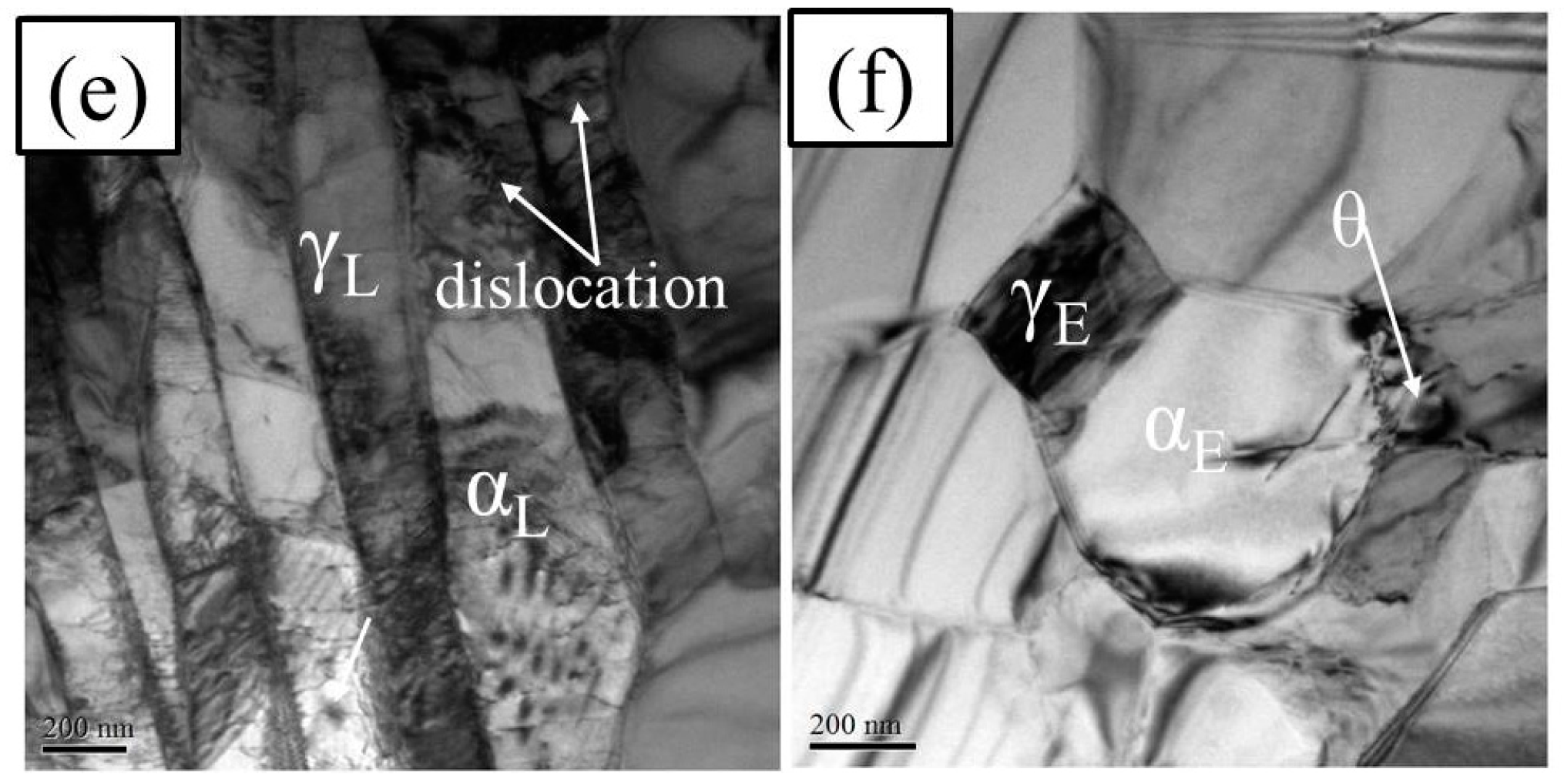


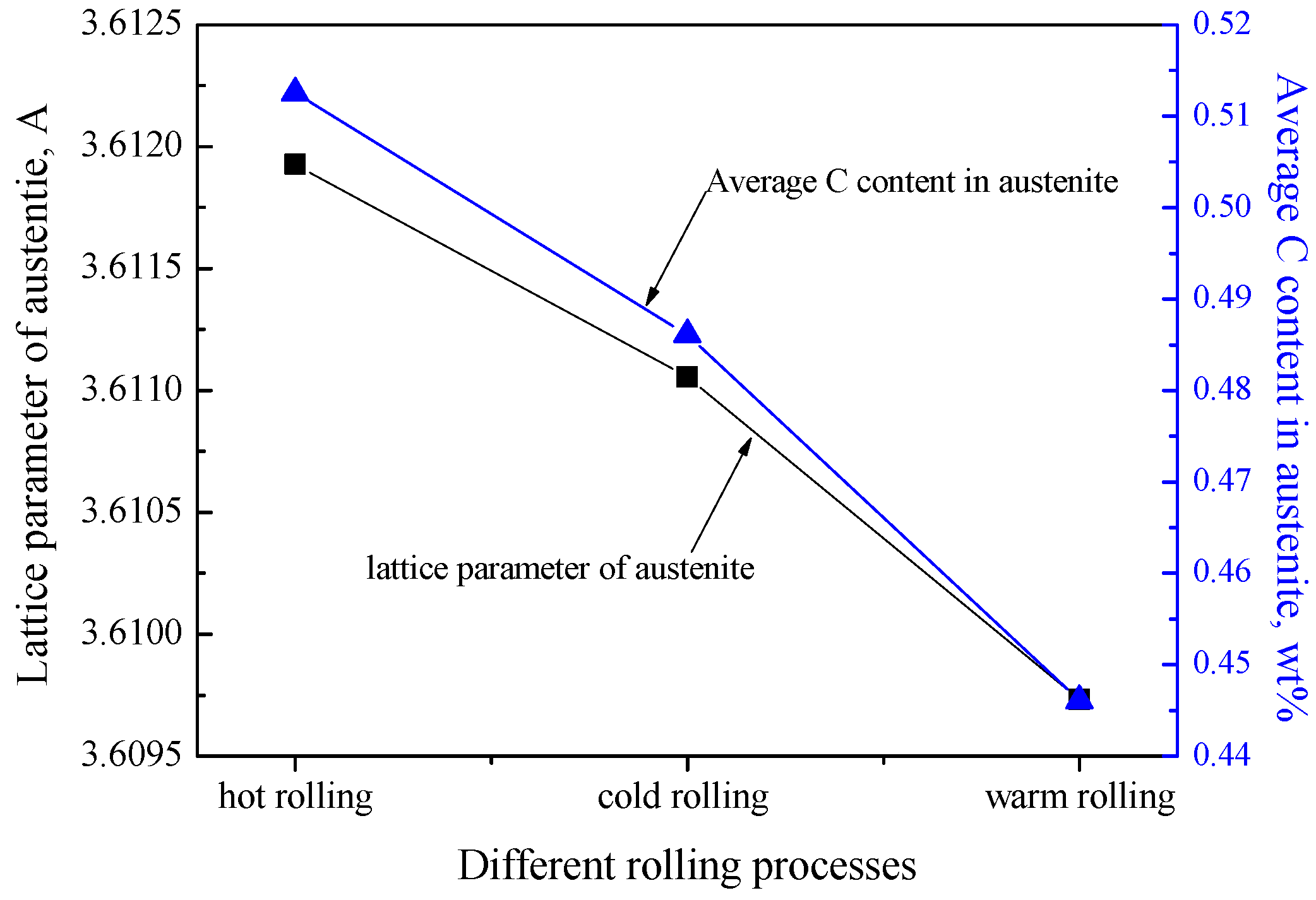
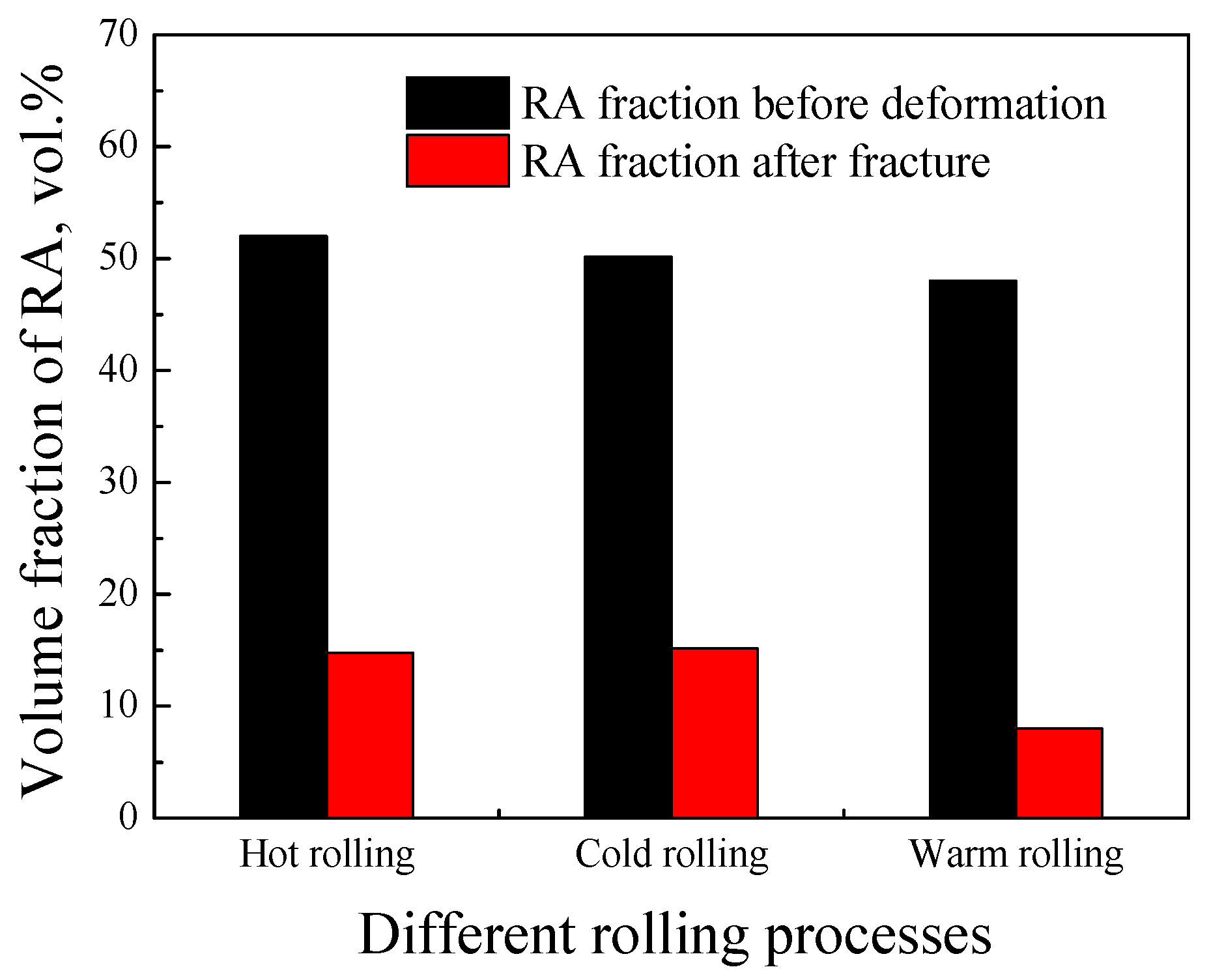
| Rolling Processes | UTS/MPa | YS/MPa | TE/% | YPE/% | The Onset of DSA/% |
|---|---|---|---|---|---|
| Hot rolling | 937 ± 5.8 | 631 ± 2.1 | 58.4 ± 3.7 | 19.0 ± 1.6 | |
| Cold rolling | 910 ± 56.6 | 596 ± 2.83 | 42.1 ± 10.8 | 4.0 ± 0.78 | 23.5 ± 0.6 |
| Warm rolling | 943 ± 7.8 | 665 ± 21.2 | 61.9 ± 1.3 | 2.8 ± 0.86 | 29.7 ± 3.7 |
© 2017 by the authors. Licensee MDPI, Basel, Switzerland. This article is an open access article distributed under the terms and conditions of the Creative Commons Attribution (CC BY) license (http://creativecommons.org/licenses/by/4.0/).
Share and Cite
Hu, B.; Luo, H. Microstructures and Mechanical Properties of 7Mn Steel Manufactured by Different Rolling Processes. Metals 2017, 7, 464. https://doi.org/10.3390/met7110464
Hu B, Luo H. Microstructures and Mechanical Properties of 7Mn Steel Manufactured by Different Rolling Processes. Metals. 2017; 7(11):464. https://doi.org/10.3390/met7110464
Chicago/Turabian StyleHu, Bin, and Haiwen Luo. 2017. "Microstructures and Mechanical Properties of 7Mn Steel Manufactured by Different Rolling Processes" Metals 7, no. 11: 464. https://doi.org/10.3390/met7110464





